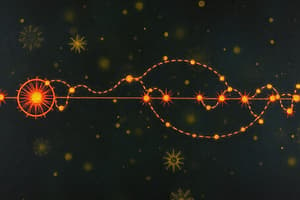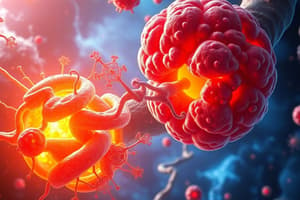Podcast
Questions and Answers
What is the primary function of cytochrome c oxidase in the electron transport chain?
What is the primary function of cytochrome c oxidase in the electron transport chain?
- It synthesizes ATP directly through substrate-level phosphorylation.
- It reduces ubiquinone to ubiquinol.
- It oxidizes NADH to generate ATP.
- It transfers electrons to oxygen while pumping protons. (correct)
Which statement correctly describes the role of ATP synthase in cellular respiration?
Which statement correctly describes the role of ATP synthase in cellular respiration?
- It acts as a proton pump to maintain membrane potential.
- It uses a proton gradient to synthesize ATP. (correct)
- It oxidizes FADH2 to produce NADH.
- It directly reduces oxygen to form water.
How many ATP can be generated from one molecule of NADH during aerobic respiration?
How many ATP can be generated from one molecule of NADH during aerobic respiration?
- 3 ATP (correct)
- 1 ATP
- 4 ATP
- 2 ATP
What is one of the two main functions of the electron transport chain?
What is one of the two main functions of the electron transport chain?
In the context of the electron transport chain, which complex is known as cytochrome bc1?
In the context of the electron transport chain, which complex is known as cytochrome bc1?
What role does NADH play in oxidative phosphorylation?
What role does NADH play in oxidative phosphorylation?
What is the function of chemiosmosis in oxidative phosphorylation?
What is the function of chemiosmosis in oxidative phosphorylation?
Which statement is true about complex II in the electron transport chain?
Which statement is true about complex II in the electron transport chain?
What happens as electrons pass through complex I of the electron transport chain?
What happens as electrons pass through complex I of the electron transport chain?
Which component is crucial for the binding of NADH to complex I?
Which component is crucial for the binding of NADH to complex I?
The reduction of ubiquinone to ubiquinol involves the uptake of how many protons?
The reduction of ubiquinone to ubiquinol involves the uptake of how many protons?
What occurs during the redox reactions in the electron transport chain?
What occurs during the redox reactions in the electron transport chain?
Why does complex II not contribute to the proton gradient in oxidative phosphorylation?
Why does complex II not contribute to the proton gradient in oxidative phosphorylation?
Flashcards
Cytochrome c oxidoreductase (Complex III)
Cytochrome c oxidoreductase (Complex III)
A protein complex in the electron transport chain that oxidizes ubiquinol and reduces cytochrome c, pumping protons across the membrane.
Cytochrome c oxidase (Complex IV)
Cytochrome c oxidase (Complex IV)
The final electron transport chain protein complex that transfers electrons to oxygen, reducing it to water, and pumping protons.
ATP synthase (Complex V)
ATP synthase (Complex V)
An enzyme that uses the proton gradient generated by the electron transport chain to produce ATP from ADP and phosphate.
Electron Transport Chain Function
Electron Transport Chain Function
Signup and view all the flashcards
ATP Yield
ATP Yield
Signup and view all the flashcards
Oxidative Phosphorylation
Oxidative Phosphorylation
Signup and view all the flashcards
Electron Transport Chain (ETC)
Electron Transport Chain (ETC)
Signup and view all the flashcards
Chemiosmosis
Chemiosmosis
Signup and view all the flashcards
NADH
NADH
Signup and view all the flashcards
FADH2
FADH2
Signup and view all the flashcards
Complex I (NADH Dehydrogenase)
Complex I (NADH Dehydrogenase)
Signup and view all the flashcards
Complex II (Succinate Dehydrogenase)
Complex II (Succinate Dehydrogenase)
Signup and view all the flashcards
Protons (H+)
Protons (H+)
Signup and view all the flashcards
Study Notes
Oxidative Phosphorylation
- Oxidative phosphorylation, also known as the electron transport chain, is a series of proteins and organic molecules in the inner mitochondrial membrane
- Electrons are passed from one member of the transport chain to another in redox reactions
- The electron transport chain regenerates electron carriers and makes a proton gradient.
Objectives
- Describe the movement of electrons through the electron transport chain
- State the products of oxidative phosphorylation
- Outline the role of NADH and FADH2 and electron carriers in the electron transport chain
- Describe the chemiosmotic theory of ATP production
Components of Oxidative Phosphorylation
- Complex I (NADH Dehydrogenase): NADH binds to complex I, donating electrons to flavin mononucleotide (FMN). The electrons are transferred through iron-sulfur clusters, and four protons are pumped from the matrix into the intermembrane space
- Complex II (Succinate Dehydrogenase): The only enzyme part of both the citric acid cycle and the electron transport chain. It oxidizes succinate to fumarate, reducing ubiquinone (Q). This reaction releases less energy than NADH oxidation, so no protons are pumped across the membrane.
- Complex III (Cytochrome c Reductase): Oxidizes ubiquinol (QH2) and reduces cytochrome c. One proton is transferred per cytochrome c reduced.
- Complex IV (Cytochrome c Oxidase): The final protein complex in the electron transport chain. This enzyme transfers electrons to oxygen, reducing it to water (H₂O). Protons are pumped across the membrane.
- ATP Synthase (Complex V): Uses the energy stored in the proton gradient across the membrane to produce ATP from ADP and phosphate (Pi).
Chemiosmosis
- Chemiosmosis is when H+ ions move across a semipermeable membrane (from a higher to lower concentration). The flow is down the H+ gradient created by the electron transport chain.
ATP Synthesis
- Glycolysis produces 2 ATP
- Pyruvate oxidation/Link Reaction produces 0 ATP
- Krebs cycle produces 2 ATP
- The total ATP yield of aerobic respiration is 36-38 ATP.
Studying That Suits You
Use AI to generate personalized quizzes and flashcards to suit your learning preferences.



